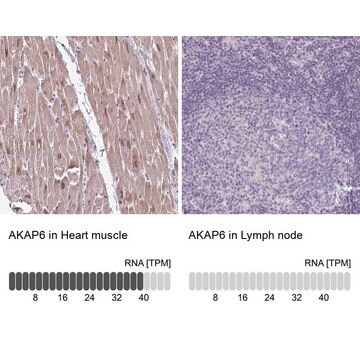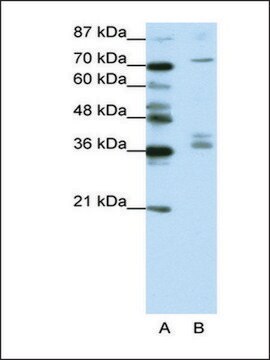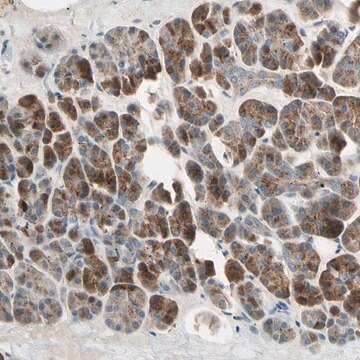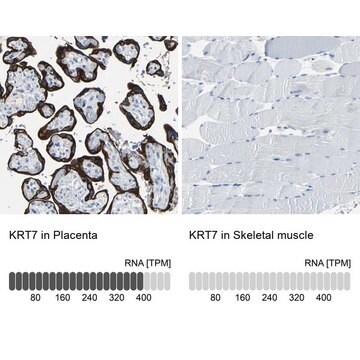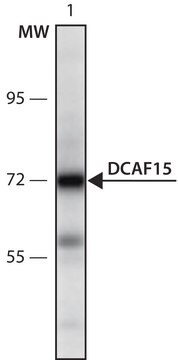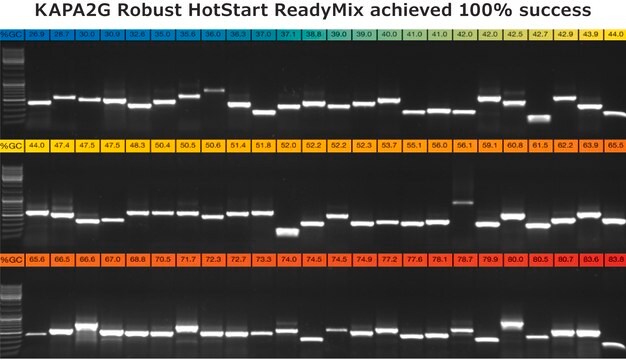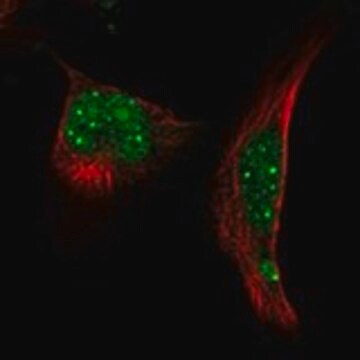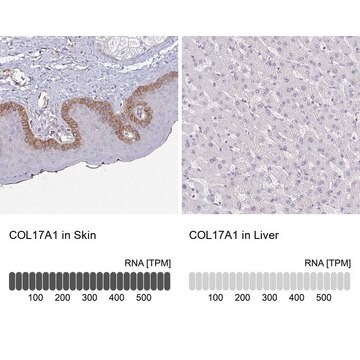HPA026109
Anti-AKAP9 antibody produced in rabbit

Prestige Antibodies® Powered by Atlas Antibodies, affinity isolated antibody, buffered aqueous glycerol solution
别名:
Anti-AKAP350, Anti-AKAP450, Anti-CG-NAP, Anti-HYPERION, Anti-KIAA0803, Anti-LQT11, Anti-MU-RMS-40.16A, Anti-PPP1R45, Anti-PRKA9, Anti-YOTIAO
登录查看公司和协议定价
所有图片(6)
About This Item
推荐产品
生物源
rabbit
品質等級
共軛
unconjugated
抗體表格
affinity isolated antibody
抗體產品種類
primary antibodies
無性繁殖
polyclonal
產品線
Prestige Antibodies® Powered by Atlas Antibodies
形狀
buffered aqueous glycerol solution
物種活性
human
加強驗證
orthogonal RNAseq
Learn more about Antibody Enhanced Validation
技術
immunofluorescence: 0.25-2 μg/mL
immunohistochemistry: 1:200-1:500
免疫原序列
KLLEAISETSSQLEHAKVTQTELMRESFRQKQEATESLKCQEELRERLHEESRAREQLAVELSKAEGVIDGYADEKTLFERQIQEKTDIIDRLEQELLCASNRLQELEAEQQQIQEERELLSRQKEAMKAEAGPVEQQLLQETE
UniProt登錄號
運輸包裝
wet ice
儲存溫度
−20°C
目標翻譯後修改
unmodified
基因資訊
human ... AKAP9(10142)
一般說明
The gene encoding A-kinase anchoring protein 9 (AKAP9) is localized to human chromosome 7q21–q22. It is a 350-450kDa protein present in the centrosomes and the Golgi apparatus.
免疫原
A-kinase anchor protein 9 recombinant protein epitope signature tag (PrEST)
應用
All Prestige Antibodies Powered by Atlas Antibodies are developed and validated by the Human Protein Atlas (HPA) project and as a result, are supported by the most extensive characterization in the industry.
The Human Protein Atlas project can be subdivided into three efforts: Human Tissue Atlas, Cancer Atlas, and Human Cell Atlas. The antibodies that have been generated in support of the Tissue and Cancer Atlas projects have been tested by immunohistochemistry against hundreds of normal and disease tissues and through the recent efforts of the Human Cell Atlas project, many have been characterized by immunofluorescence to map the human proteome not only at the tissue level but now at the subcellular level. These images and the collection of this vast data set can be viewed on the Human Protein Atlas (HPA) site by clicking on the Image Gallery link. We also provide Prestige Antibodies® protocols and other useful information.
The Human Protein Atlas project can be subdivided into three efforts: Human Tissue Atlas, Cancer Atlas, and Human Cell Atlas. The antibodies that have been generated in support of the Tissue and Cancer Atlas projects have been tested by immunohistochemistry against hundreds of normal and disease tissues and through the recent efforts of the Human Cell Atlas project, many have been characterized by immunofluorescence to map the human proteome not only at the tissue level but now at the subcellular level. These images and the collection of this vast data set can be viewed on the Human Protein Atlas (HPA) site by clicking on the Image Gallery link. We also provide Prestige Antibodies® protocols and other useful information.
生化/生理作用
A-kinase anchoring protein 9 (AKAP9) is used by cells to anchor the regulatory subunit of type II cAMP-dependent protein kinase A. It coordinates multiple intracellular signaling events and scaffolds protein kinases and phosphatases at the centrosome and the Golgi apparatus. The protein interacts with cdc42 interacting protein 4 (CIP4) at the Golgi apparatus and functions in the maintenance of normal structure of Golgi apparatus.
特點和優勢
Prestige Antibodies® are highly characterized and extensively validated antibodies with the added benefit of all available characterization data for each target being accessible via the Human Protein Atlas portal linked just below the product name at the top of this page. The uniqueness and low cross-reactivity of the Prestige Antibodies® to other proteins are due to a thorough selection of antigen regions, affinity purification, and stringent selection. Prestige antigen controls are available for every corresponding Prestige Antibody and can be found in the linkage section.
Every Prestige Antibody is tested in the following ways:
Every Prestige Antibody is tested in the following ways:
- IHC tissue array of 44 normal human tissues and 20 of the most common cancer type tissues.
- Protein array of 364 human recombinant protein fragments.
聯結
Corresponding Antigen APREST86828
外觀
Solution in phosphate-buffered saline, pH 7.2, containing 40% glycerol and 0.02% sodium azide
法律資訊
Prestige Antibodies is a registered trademark of Merck KGaA, Darmstadt, Germany
免責聲明
Unless otherwise stated in our catalog or other company documentation accompanying the product(s), our products are intended for research use only and are not to be used for any other purpose, which includes but is not limited to, unauthorized commercial uses, in vitro diagnostic uses, ex vivo or in vivo therapeutic uses or any type of consumption or application to humans or animals.
未找到合适的产品?
试试我们的产品选型工具.
儲存類別代碼
10 - Combustible liquids
水污染物質分類(WGK)
WGK 1
Petra Gimpel et al.
Current biology : CB, 27(19), 2999-3009 (2017-10-03)
The nucleus is the main microtubule-organizing center (MTOC) in muscle cells due to the accumulation of centrosomal proteins and microtubule (MT) nucleation activity at the nuclear envelope (NE) [1-4]. The relocalization of centrosomal proteins, including Pericentrin, Pcm1, and γ-tubulin, depends
Ei Leen Leong et al.
Human molecular genetics, 32(2), 177-191 (2022-08-05)
Mutations in LMNA, the gene encoding A-type lamins, cause laminopathies-diseases of striated muscle and other tissues. The aetiology of laminopathies has been attributed to perturbation of chromatin organization or structural weakening of the nuclear envelope (NE) such that the nucleus
Ian Holt et al.
Scientific reports, 9(1), 14202-14202 (2019-10-04)
Nesprins, nuclear envelope spectrin-repeat proteins encoded by the SYNE1 and SYNE2 genes, are involved in localization of nuclei. The short isoform, nesprin-1-alpha2, is required for relocation of the microtubule organizer function from centromeres to the nuclear rim during myogenesis. Using
Silvia Vergarajauregui et al.
eLife, 9 (2020-12-10)
The switch from centrosomal microtubule-organizing centers (MTOCs) to non-centrosomal MTOCs during differentiation is poorly understood. Here, we identify AKAP6 as key component of the nuclear envelope MTOC. In rat cardiomyocytes, AKAP6 anchors centrosomal proteins to the nuclear envelope through its
M Cecilia Larocca et al.
Molecular biology of the cell, 15(6), 2771-2781 (2004-03-30)
The A kinase anchoring protein 350 (AKAP350) is a multiply spliced type II protein kinase A anchoring protein that localizes to the centrosomes in most cells and to the Golgi apparatus in epithelial cells. In the present study, we sought
我们的科学家团队拥有各种研究领域经验,包括生命科学、材料科学、化学合成、色谱、分析及许多其他领域.
联系技术服务部门